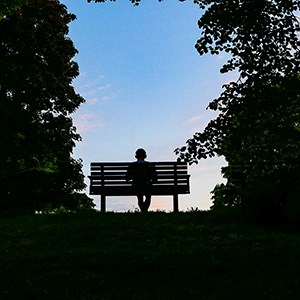Why do we feel good in nature?
– When we are out in nature, we “rest” – above all, the brain is allowed the opportunity to rest and recover in the type of environment for which it was developed. People usually talk about focused attention and spontaneous attention. Focused attention requires more energy with the brain at high-speed and making many and quick decisions, for instance when driving a car. Spontaneous attention is when we only make impressions with our senses; we note colours, shapes, scents, sensations on our skin, sounds, and so on.* And this is where nature comes in. Being in nature and “just being,” what some call forest bathing, and allowing the brain to spontaneously absorb the impressions of nature, provides recovery and stress reduction, explains Ann Dolling, who researches at SLU about the interaction between forest environments and human health.
Many people are now out and about in urban environments, instead of going to the gym. Where are the best places to exercise to increase our well-being?
– It’s been said that the best exercise is the one that actually happens. In that sense, choice of place has less significance. However, a challenge in times of closed gyms or self-isolation, may be to find new routines – and inspiration. Consider which places provide you with the motivation to exercise regularly. If you choose to exercise in a green environment (in the park, a forest, along the water, etc.) the space in itself will also contribute to the mental relaxation that is so much needed in times of crisis. We are fortunate in Sweden: over the past fifty years we have built up an impressive infrastructure of green spaces, outdoor gyms, hiking, biking and running tracks that offer a great variety of places to exercise, and which often are easily accessible on foot or by bicycle. Thanks to this planning and foresight in the establishment of infrastructure, you should have good possibilities to exercise outdoors, and to find a place that best suits you, says Mattias Qviström, Professor of Landscape Architecture with a special focus on spatial planning.
How will children be affected if teaching activities moves outdoors to reduce the risk of the spread of infection?
– Nature is an excellent classroom! Research shows how regular physical activity and contact with nature during the school day generates a wide range of positive effects. Better concentration, working memory, and motivation to study are just some, says Petter Åkerblom, Senior Lecturer in Landscape Architecture at SLU Uppsala and editor of the knowledge overview: Klassrum med himlen som tak [Teaching with the Sky as the Ceiling] (2018). In addition, contact with nature in general is also beneficial for the health and well-being of primary school pupils, as well as for their personal and social development. In the long run, self-esteem, impulse control, creativity and collaborative capacity are strengthened. >>Read more in this article.
Do all nature environments have the same qualities, and does it make any difference which particular one I choose?
– It depends on who you are and what your needs are at this moment. It’s all about making use of different environments and their qualities. We humans are different and we have different preferences and needs. One day we feel the need for the open spaces down by the shore and the wind that blows and meets us as we are right then and there. It may feel painful, but it can also feel nice. Another day we may need a more sheltered environment, such as the forest, where the eyes of others can’t reach us directly. My personal recommendation is to try to find a good environment that responds to you with the way you feel at that particular time. During my 13 years of research in the Alnarp Rehabilitation Garden, I have seen the same thing come up in every target group we have studied within the framework of nature-based rehabilitation – the important thing is to offer a varied environment that can suit each individual as they feel right now, stresses Anna María Pálsdóttir, a researcher in environmental psychology focusing on nature-based and nature-supported interventions.
Many senior citizens are now isolated in their homes or in nursing homes. How can their health and well-being be strengthened when contact with their surroundings and outdoor environments is reduced?
– In the current situation, I am hoping that social care workers consciously make use of the knowledge that exists about the importance of green surroundings and influences of nature for the health and well-being of the elderly. This may range from bringing in flowers, branches, and other materials from nature for the residents to see, feel, and smell; to think about the placement of furniture to offer plenty of daylight, the opportunity to feel the warmth of the sun, to get the impression of life and movement outside, and the opportunity to experience the seasonal changes. Everything with the focus on creating meaningful moments of joy and well-being, says Anna Bengtsson, who is a landscape architect with focus on environmental psychology.
